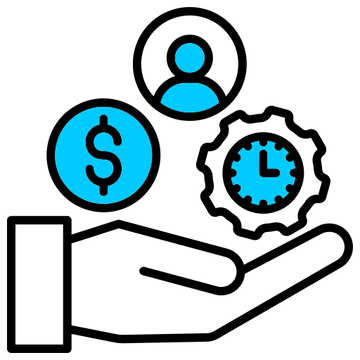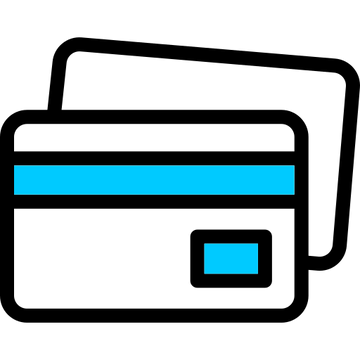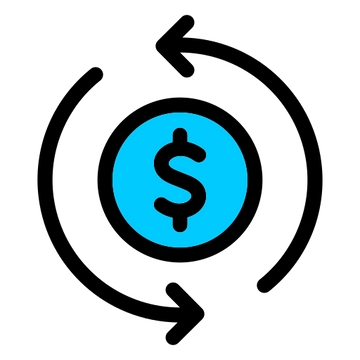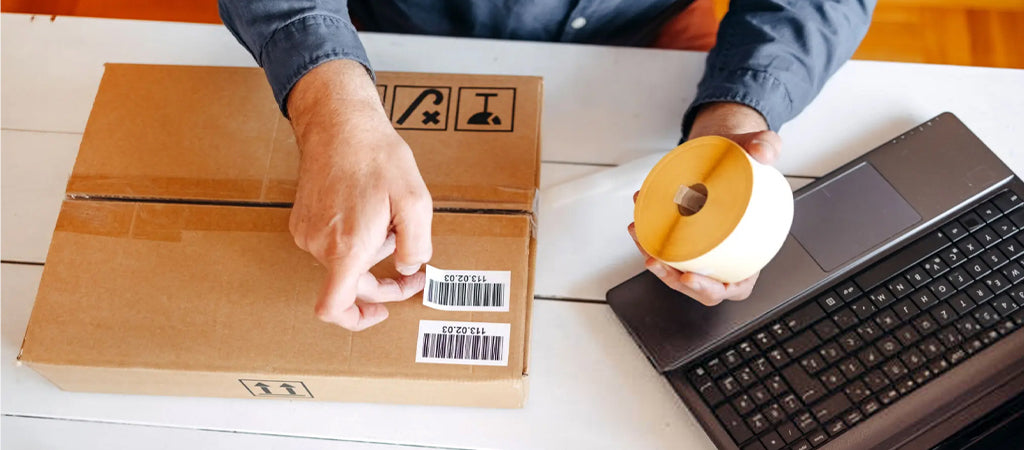

Removable Film Labels
Written by: BernauLena
|
|
Time to read 11 min
Barcodes are everywhere—from the items in your grocery cart to packages delivered to your doorstep. Whether you're a small business owner exploring barcode options, an e-commerce seller preparing to expand, or just curious about the technology behind the scenes, this guide has got you covered. In this article, we’ll answer six key questions about barcode labels, helping you understand their types, uses, costs, and more. Let’s dive in!
Table of Content
A barcode label is a small sticker or tag with black-and-white lines or patterns that store information in a way that machines can read, such as Universal Product Codes (UPCs), Stock Keeping Units (SKUs) , and Quick Response (QR) codes. These labels are like secret codes that help businesses track, manage, and identify products or shipments easily. Think of it as a link between the real world and computer systems, making everything run faster and more smoothly!
There are many forms of barcodes, the main types of which are1 D (one dimensional)and 2 D (two dimensional). 1 D carries the most basic information of a product,while 2D can store more information.
There are two main types of barcode labels you’ll see most often: 1D Barcodes and 2D Barcodes. Each type is designed for specific purposes, and here’s what makes them different:
· What They Look Like: Simple lines of varying widths, like the ones you see on grocery items.
· Examples: UPC (Univeral Product Cods), EAN (European Article Number), Code 39.
· How They Work: These barcodes store basic information, such as product IDs or numbers, in a series of vertical lines.
· Features: They can’t store much data, so they’re great for simple tracking.
· What They Look Like: Small squares or rectangles with patterns of dots or shapes, like QR codes.
· Examples: QR Codes, Data Matrix.
· How They Work: These barcodes store a lot more information, like website links, product details, or even full instructions.
· Features: They’re compact, can hold more data, and can be scanned from any angle.
In short, 1D barcodes are simple and efficient for basic tasks, while 2D barcodes are powerful for storing detailed information. Both types are super helpful, depending on what you need them for!
Time is at a premium in a growing business, so it pays to operate as efficiently as possible. Start Barcode Labeling can help your small business to increase efficiency and save time and money.
The key advantage of using barcodes within a small business (or, in fact, any business) is time savings. Business owners and key staff often spend a lot of time entering SKUs into inventory management and accounting systems, frequently to the detriment of more productive business functions.
Barcodes also lessen the frequency of errors within the inventory record. As mistakes made when recording inventory information can contribute to missed sales, excess inventory or even inventory shortages, making fewer mistakes will have a direct impact on your business’ profitability and capacity to grow.
Without barcoding, it is much more complex to operate a real-time inventory management system. A real-time inventory management system enables you to manage your business’ entire supply chain from raw material ordering to distribution. Real-time inventory control also records and allocates costs at every stage, simplifying accounting and tax reporting.
In a small business, real-time inventory control is an essential business continuity tool. For example, without barcoding, if the staff member who processes inventory movements is backlogged, on leave or unavailable, there is a risk that the inventory record will not keep up with inventory levels in the warehouse.
Barcoding can also play an important role in a small business’ risk management strategy. For example, small food and beverage manufacturers are subject to the same food safety rules but have a lot less resourcing in the event that something goes wrong. Barcoding improves the accuracy of inventory records and can also be used to ensure traceability from raw materials to each batch of finished product. In the event of a recall or food safety issue, the use of barcodes can obviously reduce the administrative burden.
If your company needs to track products, improve accuracy, or enhance efficiency, barcode labels could be the perfect solution. From global enterprises to small startups, barcodes simplify complex tasks and help businesses grow.
1. Compatibility
No matter what kind of label you choose, the first factor is to make sure the label is compatible with your printer. Different brands of printers may require labels with specific features, such as holders, sensor marks, or sensor holes.
Holders: Eg. Brother Printers
Brother printers require labels with specific holders and sensor holes on the back. If your printers are Brother, you need to ensure that the barcode labels you choose are not only placed on compatible holders but also have the correct sensor marks on the back.
Buying barcode labels directly from Brother's official source is a safe idea. However, at Betckey, we provide labels that are compatible with Brother QL printers at affordable prices. So, if you want to avoid overpriced Brother labels, save costs, or increase your profit margins, Betckey labels , which are compatible with Brother printers, will be your best choice.

Sensor Marks/Holes: Eg. Dymo Printers
An example of printers that require labels with correct sensor marks and sensor holes is Dymo printers. If third-party labels do not have these features, they are not compatible with your Dymo printer.
Additionally, when considering Dymo 550 series and 5XL series printers, you should be aware that they require labels with their unique RFID chips. The market for used Dymo 450 series printers can be confusing. You may not know if the reseller is offering the US model, which requires sensor holes only, or the European model, which requires both sensor holes and sensor marks.
Thanks to Betckey's quality control, Betckey labels compatible with Dymo printers are made with both sensor marks and sensor holes. Therefore, Betckey labels are compatible with both US models and European models.

Label Width
These days, printers that dispense labels directly, such as the Rollo printer, are becoming increasingly popular. However, the primary challenge with these labels is their printing width. For instance, the minimum printing width of Rollo printers is 1.57 inches. Therefore, you must ensure that the barcode labels you choose are wider than 1.57 inches; otherwise, they will not be compatible with the printers.
Betckey provide mutlilple size labels to fit most printer width on major market.

2. Durability/Material
Regardless of the type of labels you choose, you need to ensure that they are durable enough to allow others to scan them. In other words, your labels should remain on the inventory or package.
Most popular & Cost-effective: Paper
For most businesses where products will be stored in a normal indoor environment, paper-made labels are durable enough. Additionally, considering their low cost, paper-made labels are the right choice for most businesses' barcode labeling needs.

Envrionment-proof: Film
For businesses where your products will be stored in a freezer or other special environment, film labels that are waterproof, oil-proof, and scratch-proof are a better choice. For example, if you are running an ice cream business where you will be storing products in the refrigerator back and forth, you need to ensure that the labels are waterproof.

3. Adhesiveness: Permanent or Removable
Permanent Adhesive
Permanent adhesive labels have the stickiness found in most labels on the major market because most businesses don't need to change their barcode labels frequently. What they want is for the labels to adhere firmly to the product/package.

Removable Adhesive
Some special businesses need to change their barcode labels frequently or require labels that can be easily removed. In such cases, you should choose barcode labels with removable adhesive .
Unlike permanent adhesive labels, which are very difficult to remove, removable adhesive labels strike a balance between ease of removal and adhesiveness. When removing removable labels, there is minimal residue left behind, and you won't damage the labels to the extent that parts of them remain on the product.
4. Size: Enough Space
The last factor to consider is the size. In other words, you want your barcode labels to have enough space to print your barcode and all other information clearly so that your carriers and customers can easily scan them.
As one of the top sellers of direct thermal labels on Amazon, we also require millions of barcode labels each month to keep track of our inventory. Based on our own experience, 2-inch-wide labels are generally sufficient for barcodes. However, you can also choose the right length by considering whether you need to print additional information on the barcode.
As the leading supplier of direct thermal labels on Amazon, we also print thousands of barcode labels each month. Here are some of the labels in our collection:
The cost of barcode labels can vary depending on how you acquire them, what type you need, and how many you require. Here’s a breakdown of the key factors and costs involved in using barcode labels:
If you want official, globally recognized barcodes (like UPC or EAN), you need to register with GS1 , the global organization that manages barcode standards.
· Initial Registration Fee:
o Small businesses can expect to pay around $250–$750 upfront, depending on the number of barcodes they need. For 10 UPCs/EANs it will cost $250 and there are also annual renewal fees. It’s typically free to generate SKUs and QR codes.
· Annual Renewal Fee:
o Ranges from $50–$3,000+, depending on your company size and how many products you’re managing.
Why GS1: Paid barcodes, like those from GS1, play a vital role in data management and analysis, linking with POS systems to track sales, inventory, and consumer behavior for better decision-making. They also ensure compliance with industry regulations in sectors like food, healthcare, and pharmaceuticals by enabling batch tracking, recalls, and traceability, making them essential for operational efficiency and legal adherence. If your business plans to expand retail channels or optimize the supply chain, investing in paid barcodes is absolutely worth it!
If you don’t register directly with GS1, you can purchase barcodes from authorized resellers. These are often more affordable for small businesses that only need a few barcodes.
· Cost Per Barcode: Typically $10–$30 per barcode.
· Limitations: Reseller barcodes might not be accepted by some platforms, such as Amazon, which requires GS1-registered codes.
Yes, barcode resellers are legitimate businesses. They resell previously registered GS1 barcodes, which are valid and unique. Just enter “UPC Barcode Reseller” and these platforms pops out. However, these barcodes remain tied to the original company prefix and are not registered under your business name in the GS1 database, which could cause issues with certain platforms or retailers.
· Ideal for small businesses or startups with limited budgets.
· Suitable if you’re not selling on platforms like Amazon or major retailers.
· Best for internal use or local sales where barcode verification isn’t required.
· Avoid if you plan to sell on platforms like Amazon or Walmart, which require GS1-registered codes under your company name.
· Not recommended for industries with strict regulations (e.g., food, pharmaceuticals).
· Avoid if you want full ownership and scalability for long-term business growth.
Yes, there are free options for generating barcode images. Many online tools and software allow you to create barcodes at no cost. However, these barcodes are not registered in the GS1 database, which means they are unlikely to be accepted by major retailers, e-commerce platforms, or logistics systems. So if you only use barcodes to manage your inventory, we recommand you use these free barcode.
Creating barcode labels is simpler than you might think! Depending on your needs, you can use tools like Excel and Word, a Retail POS system, or free barcode generator tools.
1. Using Excel or Word
You can use Excel or Word to design and print barcode labels. here is a step by step guide for you to refer to: How to make barcodes through Excel or Word . This method is a bit complicated at first, but once you mastered, they offer a lot benefits. For example, they allow batch processing, flexible data management, and customizable designs for barcode labels. These tools also work offline, offer full control over formatting, and are cost-effective for businesses already using Office software. In contrast, online barcode generator tools rely on the internet and may require fees if you need more functions.
2. Using a Retail POS System
If you’re running a retail business, most POS systems, like Square, can automatically create a unique barcode based on each item’s product SKU or UPC. You can also print your barcodes straight from your POS account onto a product label.
Free Barcode Generator Tools
If you're looking for quick and easy ways to create barcodes for your business, here are three reliable free barcode generator tools to try:
Back-to-school season often comes with a bit of chaos, but these small labels can help bring some order to the madness. Whether you’re managing your family’s school gear or organizing your classroom, labels are a simple yet effective solution. We recommend using removable labels for all your needs—they’re easy to peel off and won’t leave any sticky residues behind. Contact our customer service team now to check what kind of labels you need!
About Betckey
Betckey Premium Labels is a leading supplier of compatible direct thermal labels, committed to high-quality and eco-friendly products as well as competitive pricing. We offer better products than manufactured original at 70% less price. Now, our Amazon store ranks first in the US, Canada, and Western Europe with thousands of positive ratings. Visit betckey.com and get 10% off purchases over $150 with code Betckey10 and 15% off over $400 with code Betckey15! Sign up now and we'll send you a $5 discount code towards your first purchase. By the way, welcome to follow our official @ Tik Tok and @ Youtube accounts to get Betckey’s latest news!
If you want to buy thermal labels or sticker paper, you can check out more on our store

24/7 support team

Multiple Payment Methods

Worry-free shopping

Delivery in 3-7 business days
Be the first to know about label discounts,
product launches, and time-saving tips — subscribe now!
Are you 18 years old or older?
Sorry, the content of this store can't be seen by a younger audience. Come back when you're older.
Everithing was really good, fast delivery, product quality 100% guarantee
Very versatile label for mailing addresses and a marketing to promote a product or get someone’s attention.
Brother DK-2205 Compatible Continuous Labels 2.4" x 100'
Great little labels to use in pricing jewelry. Saves a lot time when you use with a thermal printer. I use on the hang tags and other display cards. Will definitely reorder in the future.
The label is perfect it's very recommended to everyone
iLabel 4x6 Thermal Shipping Label Printer Bluetooth Wireless
Dymo 30256 Removable Film Waterproof Shipping Labels 2-5/16” x 4”




